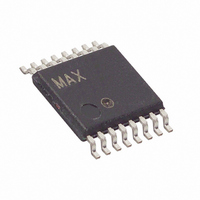DS1859E-050+T&R Maxim Integrated Products, DS1859E-050+T&R Datasheet - Page 22

DS1859E-050+T&R
Manufacturer Part Number
DS1859E-050+T&R
Description
IC RES TEMP 50/50K 3MON 16-TSSOP
Manufacturer
Maxim Integrated Products
Datasheet
1.DS1859E-050.pdf
(28 pages)
Specifications of DS1859E-050+T&R
Taps
256
Resistance (ohms)
50K
Number Of Circuits
2
Temperature Coefficient
50 ppm/°C Typical
Memory Type
Non-Volatile
Interface
I²C, 2-Wire Serial
Voltage - Supply
2.85 V ~ 5.5 V
Operating Temperature
-40°C ~ 95°C
Mounting Type
Surface Mount
Package / Case
16-TSSOP
Resistance In Ohms
50K
Lead Free Status / RoHS Status
Lead free / RoHS Compliant
The following equation can be used to determine which
resistor position setting, 00h to FFh, should be written in
the LUT to achieve a given resistance at a specific tem-
perature.
R = the resistance desired at the output terminal
C = temperature in degrees Celsius
u, v, w, x
corresponding look-up tables. The variable x from the
equation above is separated into x
(the LSB of x). Their addresses and LSB values are given
below. Resistor 0 variables are found in Table 1, and
Resistor 1 variables are found in Table 2.
When shipped from the factory, all other memory loca-
tions in the LUTs are programmed to FFh.
Table 8. Calibration Constants
The DS1859 has two methods for scaling an analog
input to a digital result. The two methods are gain and
offset. Each of the inputs (V
MON3) has a unique register for the gain and the offset
found in Table 01h, 92h to 99h, and A2h to A9h.
To scale the gain and offset of the converter for a spe-
cific input, you must first know the relationship between
the analog input and the expected digital result. The
input that would produce a digital result of all zeros is
the null value (normally this input is GND). The input
that would produce a digital result of all ones is the full-
scale (FS) value. The FS value is also found by multiply-
ing an all-ones digital answer by the weighted LSB
(e.g., since the digital reading is a 16-bit register, let us
Dual, Temperature-Controlled Resistors with
Internally Calibrated Monitors
pos
22
= 3.852357 for the 20k resistor
= 4.5680475 for the 50k resistor
ADDRESS (Hex)
____________________________________________________________________
Programming the Look-up Table (LUT)
R C
,
FA
FB
FC
FD
F8
F9
FE
FF
1
, x
0
, y, and z are calculated values found in the
R u
x
•
•
1
1
y
VARIABLE
v
Reserved
•
•
C
x
x
w
C
u
v
y
z
1
0
Internal Calibration
CC
25
25
1
, MON1, MON2, and
(the MSB of x) and x
z
w
•
•
C
2E-6 (signed)
C
25
100E-9
20E-6
10E-9
25
LSB
2
2
2
—
-7
2
0
1
2
0
assume that the LSB of the lowest weighted bit is
50µV, then the FS value is 65,535 x 50µV = 3.27675V).
A binary search is used to scale the gain of the con-
verter. This requires forcing two known voltages to the
input pin. It is preferred that one of the forced voltages
is the null input and the other is 90% of FS. Since the
LSB of the least significant bit in the digital reading reg-
ister is known, the expected digital results are also
known for both inputs (null/LSB = CNT1 and 90%FS/
LSB = CNT2).
The user might not directly force a voltage on the input.
Instead they have a circuit that transforms light, fre-
quency, power, or current to a voltage that is the input
to the DS1859. In this situation, the user does not need
to know the relationship of voltage to expected digital
result but instead knows the relationship of light, fre-
quency, power, or current to the expected digital result.
Figure 4. Look-Up Table Hysteresis
M6
M5
M4
M3
M2
M1
2
4
TEMPERATURE
DECREASING
TEMPERATURE ( C)
6
TEMPERATURE
INCREASING
8
10
12











